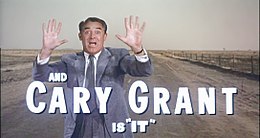Mt Rushmore..............our national treasure..........my father.......
Meanwhile, a government intelligence agency in
Washington, D.C. read the news and realize that Thornhill has been mistaken for "George Kaplan", a fictional persona created by the agency to thwart Vandamm. However, Thornhill is not rescued for fear of compromising their operation.

Thornhill (Grant) stopping a truck while being attacked by the crop duster plane, in a screenshot from the film trailer
Thornhill sneaks onto the
20th Century Limited train. He meets Eve Kendall (
Eva Marie Saint), who hides him from the police. Kendall and Thornhill begin to establish a relationship but Kendall, unbeknownst to Thornhill, is actually working with Vandamm and his thugs. In
Chicago, Kendall tells Thornhill she has arranged a meeting with Kaplan at an isolated bus stop. Thornhill waits at the bus stop, but Kaplan never shows up. He is then attacked by a
crop duster plane. After unsuccessfully trying to hide in the fields, he steps in front of a speeding
tank truck and the airplane crashes into it, leaving Thornhill to escape in a stolen pickup truck when traffic stops.
When he reaches Kaplan's hotel in Chicago, he discovers that Kaplan had checked out and left before Kendall
